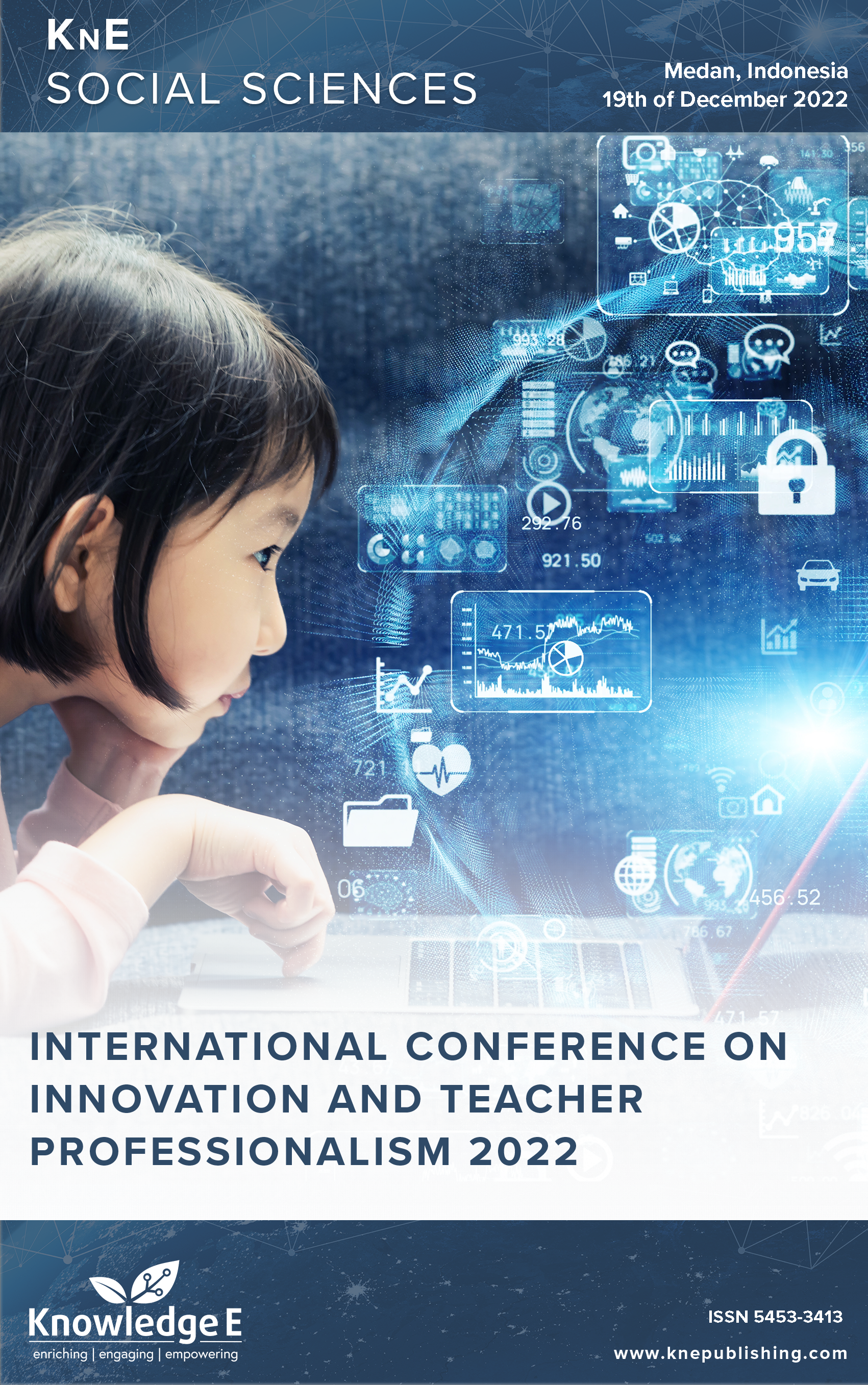Ecohistory: The Concept of Environmentally Learning and Disaster Mitigation to Realize Society 5.0
DOI:
https://doi.org/10.18502/kss.v8i10.13439Abstract
This article discusses a new concept in history learning with a thematic history approach, namely environmental history. This concept is needed forlearning in schools in order to achieve several SDGs indicators, to welcome Society 5.0, and to meet the needs of learning innovation in the Merdeka Curriculum. This study uses qualitative research methods with data collection techniques through in-depth interviews, documentation, literature, and questionnaires. Data analysis was carried out by: (1) data reduction; (2) data presentation; and (3) data verification. The results of this study consist of theoretical basis for the implementation of thematic history learning in schools; the concept of Ecohistory and its relevance to the achievement of the SDGs to meet Society 5.0; and its implementation at school.
Keywords: learner-centered instruction, teacher-centered instruction, English proficiency, student teachers
References
[2] Anderson A. “Climate change education for mitigation and adaptation.” J Educ Sustain Dev. 2012;6(2):191–206. doi: 10.1177/0973408212475199.
[3] Prihantoro CR. “The perspective of curriculum in Indonesia on environmental education.” Int J Res Studs Educ. 2014;4(1):77–83. doi:10.5861/ijrse.2014.915.
[4] Hayudityas B. ”Importance of implementation of disaster mitigation education in school to know student preparedness.” J Informal Educ. 2020;1(2):94–102. [Online]. Available: http://repositorio.unan.edu.ni/2986/1/5624.pdf.
[5] Tyas RA, Pujianto P, Suyanta S. “Evaluation of the management of the disaster preparedness school program (SSB).” J Manage Account Educ. 2020;8(1):10–23. doi:10.21831/jamp.v8i1.28850.
[6] Amri A, Hanifa NR, Tebe Y, Lassa J, Pradipta GC, Furqon MR, et al. “National Evaluation of the Disaster Safe Education Unit Program,” 2020.
[7] UNISDR. “Comprehensive Safe Schools,” 2017.
[8] Rousell D, Cutter-Mackenzie-Knowles A. “A systematic review of climate change education: giving children and young people a ’voice’ and a ’hand’ in redressing climate change.” Children Geogr. 2020;18(2):191–208. doi:10.1080/14733285.2019.1614532
[9] Parikesit, Withaningsih S. “The need for sustainability science education in Indonesia.”AIP Conf Proc. 2018 ;2019(October 2018). doi: 10.1063/1.5061863
[10] Hero. Evaluation: Theory, model, methodology, standard, application and profession. Jakarta: Rajawali Press, 2016.
[11] Sugiyono. Educational research methods (quantitative, qualitative, and R&D approaches). Bandung: Alfabeta; 2015.
[12] Nair MM, Tyagi AK, Sreenath N. “The future with industry 4.0 at the core of society 5.0: Open issues, future opportunities and challenges.” In 2021 International Conference on Computer Communication and Informatics (ICCCI); 2021. pp. 1–7.
[13] Purwanto MB, Devi D, Nuryani N. “Learning the disruptive era towards society 5.0.” 2020.
[14] Handayani NNL, Muliastrini NKE. “Disruptive era learning towards society 5.0 Era (Basic Education Perspective Study).” In Proceedings of the IAHN-TP Palangka Raya National Seminar. 2020;1:1–14.
[15] Ambara IMY, Margunayasa IG, Kusmariyatni NN. “Development of collaborative learning tools for mathematics subjects on the topic of data processing for fifth graders of SD A. INTRODUCTION The development of learning in the industrial revolution era 4 . 0 synergizes with 21st century learning that demands d participants.” 2019;9(September):112–122. doi:10.25273/pe.v9i2.4671.
[16] LAW OF THE REPUBLIC OF INDONESIA NUMBER 24 OF 2007 CONCERNING DISASTER MANAGEMENT. 2007.
[17] BNPB. ”Distribution of natural disasters per January 1 - August 1, 2022.” 2022. doi: https://gis.bnpb.go.id/arcgis/apps/sites/#/public/pages/bencana-besar-tahun- 2022.
[18] Juhadi, Herlina M. Disaster mitigation literacy education in schools. Kudus: PARIST PUBLISHER: Holy: PARIST PUBLISHER; 2020.
[19] Koswara A, et al. Disaster Resilient Education: Creating a Disaster Safe Education Unit in Indonesia. Jakarta: “Creating a Disaster-Safe Education Unit in Indonesia” DISASTER RESPONSIBLE EDUCATION NATIONAL SECRETARIAT DISASTER SAFE EDUCATION UNIT (SEKNAS SPAB): Jakarta: “Creating a Disaster-Safe Education Unit in Indonesia” TANGGUH NATIONAL SECRETARIAT EDUCATION UNIT, SPACEDICATION UNIT (SEKNASAMAN), 2019.
[20] Suarmika PE, Utama EG. “Disaster mitigation education in elementary schools (an ethnopedagogical analysis study).” J Educ Indonesian Basics - JPDI. 2017;2(2):18–24.
[21] Santoso AB, Setyaningsih W, Biqih D. “The role of teachers and students in school pioneering activities and natural disaster mitigation (SWALIBA)” In Social Science Forum. 2016;43(2):176–188.
[22] Suharini E, DL S, Kurniawan E. ”Disaster learning for communities in flood-prone areas of the Beringin Watershed, Semarang City.” In Social Science Forum. 2015;42(2):184–195.
[23] Efendi M, Nasruddin N, Karani S. ”School participation in disaster resilient learning communities in wetland environments.” J Educ Geogr - JPIG. 2022;7(2):97–109.
[24] Kelman I, Gaillard JC, Lewis J, Mercer J. “Learning from the history of disaster vulnerability and resilience research and practice for climate change.” Nat Hazards. 2016;82(1):129–143. doi:10.1007/s11069-016-2294-0
[25] Karl W. The hydraulic civilizations. Routlegde, 2017
[26] Djono D, Joebagio H, Abidin NF. “Integrative-multidimensional historical movement: Sartono Kartodirdjo’s legacy for the philosophy of historical education towards society 5.0.” Criksetra J Educ Sej. 2020;9(1):32–46. doi:10.36706/jc.v9i1.10258.
[27] Kartodirdjo S. Development culture in historical perspective. Yogyakarta: Gadjahmada University Press; 1990.
[28] Ryan A, Cotton D. “Times of change: Shifting pedagogy and curricula for future sustainability.” Sustain Univ Prog Prospect. 2013;151–167. doi: 10.4324/9780203101780.
[29] Genisa MU, Subali B, Djukri, Agussalim A, Habibi H. “Socio-scientific issues implementation as science learning material.” Int J Eval Res Educ. 2020;9(2):311– 317. doi:10.11591/ijere.v9i2.20530.
[30] Field E. “Climate change: Imagining, negotiating, and co-creating future(S) with children and youth.” Curric Perspective. 2017;37(1):83–89. doi:10.1007/s41297-017- 0013-y.
[31] Dewi RP, Khoirunisa N. “Middle school student’s perception of climate change at Boyolali District, Indonesia.” IOP Conf Ser Earth Environ Sci. 2018;200(1). doi:10.1088/1755-1315/200/1/012061.
[32] Stevenson RB, Nicholls J, Whitehouse H. “What is climate change education?” Curric Perspective. 2017;37(1):67–71. doi:10.1007/s41297-017-0015-9.
[33] Monroe MC, Plate RR, Oxarart A, Bowers A, Chaves WA. “Identifying effective climate change education strategies: A systematic review of the research,”environment. Educ Res. 2019;25(6):791–812. doi:10.1080/13504622.2017.1360842.

